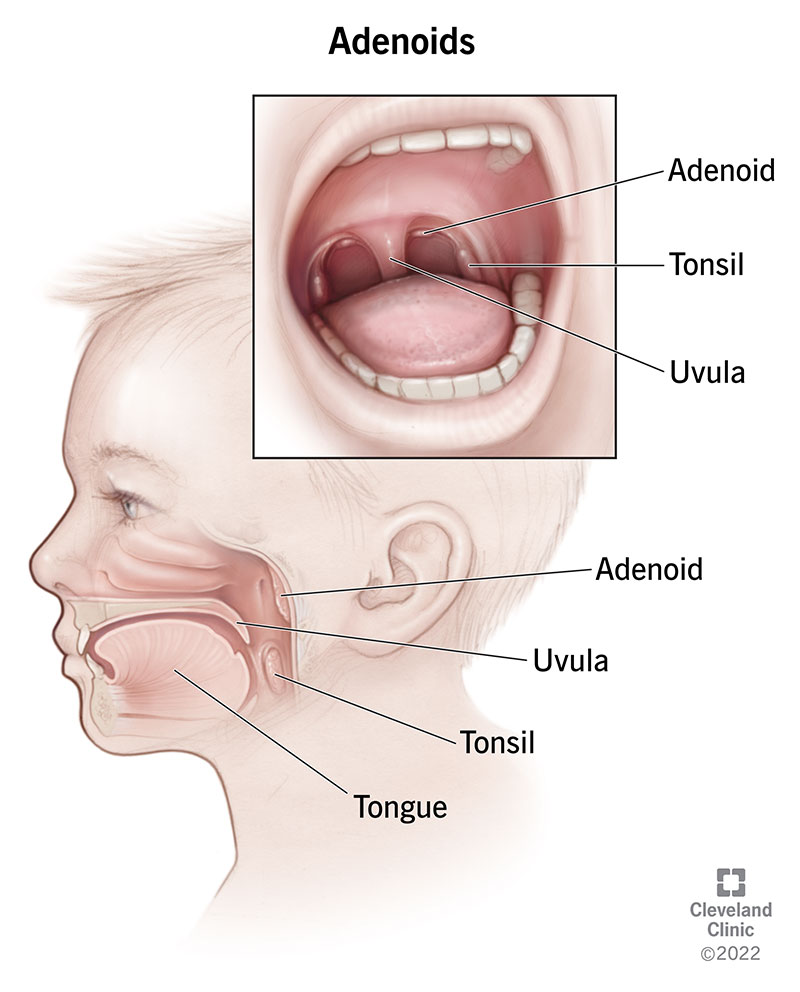Your adenoids are part of your immune system. Located just behind your nasal passage, your adenoids help trap germs that enter your body through your nose and mouth. Your adenoids begin to shrink around age 5, and usually disappear by adulthood.
Advertisement
Cleveland Clinic is a non-profit academic medical center. Advertising on our site helps support our mission. We do not endorse non-Cleveland Clinic products or services. Policy

Your adenoids are glands located in your upper airway, just behind your nasal cavity. Part of your lymphatic and immune system, your adenoids help fight off germs that you breathe in through your mouth and nose.
Advertisement
Cleveland Clinic is a non-profit academic medical center. Advertising on our site helps support our mission. We do not endorse non-Cleveland Clinic products or services. Policy
Adenoids have an important job for babies and young children. They help fight off germs until your child’s body develops another way to combat infections. Here are some interesting facts about adenoids:
Like your tonsils, your adenoids help fight off bacteria and viruses. White blood cells make this possible. They travel through your adenoids, targeting and trapping germs.
Your adenoids also produce antibodies (proteins in your blood that help fight unknown invaders in your body).
Your adenoids sit above your soft palate, directly behind your nasal passage. Unlike your tonsils, you can’t see your adenoids by looking at your throat.
Your adenoids look like a pink patch of soft tissue. Some people describe the tissue mass as “cauliflower-like.”
The average size of a normal (non-enlarged) adenoid is 6.2 millimeters. The average size of an enlarged adenoid is 11.6 millimeters. (Adenoids can become enlarged due to infection, allergies or other irritants.)
Your adenoids are made of lymphoid tissue — the same type of tissue that your lymph nodes are made of. Lymphoid tissue consists of connective tissue and white blood cells, especially lymphocytes. Lymphocytes make antibodies and play a role in immune response.
Advertisement
When your child’s body is trying to fight something off, their adenoids can become inflamed and enlarged. Enlarged adenoids are most commonly due to:
Children with enlarged adenoids may not develop symptoms at all. But in some cases, enlarged adenoids can lead to:
If your child’s healthcare provider suspects an issue with your child’s adenoids, they may recommend tests, including:
Healthcare providers usually start by treating the suspected underlying condition. If nonsurgical treatments don’t work, your child’s healthcare provider might recommend an adenoidectomy.
Once your healthcare provider figures out what’s causing enlarged adenoids, they can begin by treating the root cause. For example, if your child’s adenoids are enlarged because of allergies, then your child’s healthcare provider may prescribe antihistamines or a nasal corticosteroid spray. If your child’s adenoids are inflamed due to a bacterial infection, then they’ll likely prescribe antibiotics.
If nonsurgical methods don’t fix the issue, then your healthcare provider might recommend an adenoidectomy — a surgery to remove your child’s adenoids.
During this outpatient procedure, your child’s surgeon removes your child’s adenoids under general anesthesia. They might do this with traditional instruments or cautery.
Most children recover from adenoidectomy within two to three days. According to research studies, adenoid removal doesn’t increase the frequency of colds or infections.
Adenoids are tiny glands with a big job. They help keep your child healthy until their body finds other ways to fight off germs. Sometimes though, adenoids can become enlarged or inflamed. Nasal steroid sprays, antihistamines, antibiotics and other medications can usually address the issue. But if your child has chronically enlarged adenoids, your child’s healthcare provider may recommend an adenoidectomy. Ask your child’s healthcare provider which treatment option is best for your child.
Advertisement
Watching your child struggle to breathe and get a good night’s rest can be hard. Cleveland Clinic experts can treat their enlarged adenoids with an adenoidectomy.

Last reviewed on 06/07/2022.
Learn more about the Health Library and our editorial process.